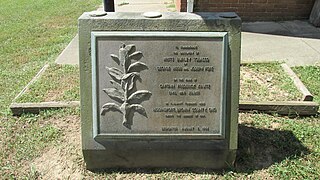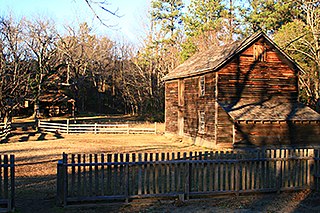
North Carolina is a state in the Southeastern region of the United States. North Carolina is the 28th largest and 9th-most populous of the 50 United States. It is bordered by Virginia to the north, the Atlantic Ocean to the east, Georgia and South Carolina to the south, and Tennessee to the west. Raleigh is the state's capital and Charlotte is its largest city. The Charlotte metropolitan area, with an estimated population of 2,569,213 in 2018, is the most-populous metropolitan area in North Carolina, the 23rd-most populous in the United States, and the largest banking center in the nation after New York City. The Raleigh-Durham-Cary combined statistical area is the second-largest metropolitan area in the state, with an estimated population of 2,079,687 in 2019, and is home to the largest research park in the United States, Research Triangle Park.

Tobacco is the common name of several plants in the Nicotiana genus of the Solanaceae family, and the general term for any product prepared from the cured leaves of these plants. More than 70 species of tobacco are known, but the chief commercial crop is N. tabacum. The more potent variant N. rustica is also used in some countries.

Danville is an independent city in the Commonwealth of Virginia in the United States, located on the fall line of the Dan River. It was a major center of Confederate activity during the American Civil War, due to its strategic location on the Richmond and Danville Railroad, and in April 1865 it briefly served as the final capital of the Confederacy before the South surrendered.

Granville County is a county located on the northern border of the U.S. state of North Carolina. As of the 2010 Census, the population was 59,916. Its county seat is Oxford.

Caswell County is a county located in the U.S. state of North Carolina. It is part of the Greensboro-High Point Metropolitan Statistical Area. As of the 2010 census, the population was 23,719. Its county seat is Yanceyville.

Winston-Salem is a city in and the county seat of Forsyth County, North Carolina, United States. In 2020, the population was 249,545 making it the second largest municipality in the Piedmont Triad region, the fifth most populous city in North Carolina, the third largest urban area in North Carolina, and the 89th most populous city in the United States. With a metropolitan population of 679,948 it is the fourth largest metropolitan area in North Carolina. Winston-Salem is home to the tallest office building in the region, 100 North Main Street, formerly known as the Wachovia Building and now known locally as the Wells Fargo Center.

Durham, also known as the "Bull City", is a city in and the county seat of Durham County in the U.S. state of North Carolina. Small portions of the city limits extend into Orange County and Wake County. With a population of 283,506 in the 2020 Census, Durham is the 4th-most populous city in North Carolina, and the 75th-most populous city in the United States. The city is located in the east-central part of the Piedmont region along the Eno River. Durham is the core of the four-county Durham-Chapel Hill Metropolitan Area, which has a population of 644,367 as of U.S. Census 2019 Population Estimates. The Office of Management and Budget also includes Durham as a part of the Raleigh-Durham-Cary Combined Statistical Area, commonly known as the Research Triangle, which has a population of 2,079,687 as of U.S. Census 2019 Population Estimates.

James Buchanan Duke was an American tobacco and electric power industrialist best known for the introduction of modern cigarette manufacture and marketing, and his involvement with Duke University. He was also the founder of the American Tobacco Company in 1890.

Burley tobacco is a light air-cured tobacco used primarily for cigarette production. In the United States it is produced in an eight-state belt with approximately 70% produced in Kentucky. Tennessee produces approximately 20%, with smaller amounts produced in Indiana, North Carolina, Missouri, Ohio, Virginia, Maryland, Pennsylvania and West Virginia. Burley tobacco is produced in many other countries, with major production in Brazil, Malawi and Argentina.
Tobacco Road is a term used in college sports, mainly basketball, for the four rival universities of North Carolina that play in the Atlantic Coast Conference (ACC). The term refers to the area's history as a major tobacco producer. The Tobacco Road teams represent the following universities:

Santa Fe Natural Tobacco Company is an American tobacco manufacturing company based in Oxford, NC, best known for its production of the premier Natural American Spirit cigarette brand.

The Caswell County, North Carolina, unincorporated community of Purley, along with the communities of Blanche and Providence, makes up Dan River Township. On a farm in this area a process for curing brightleaf tobacco was discovered by a slave in 1839 and improved in the 1850s. Tradition relates that the name "Purley" came from the Samuel Satterwhite Harrison House that sat on a hill and was painted a "pearly white" when such a paint scheme was a novelty. This resulted in much comment and the area eventually was named "Purley." Another community landmark is the Purley Store operated by the Pleasant family for over fifty years.
Y1 is a strain of tobacco that was cross-bred by Brown & Williamson to obtain an unusually high nicotine content. It became controversial in the 1990s when the United States Food and Drug Administration (FDA) used it as evidence that tobacco companies were intentionally manipulating the nicotine content of cigarettes. Y1 has also been investigated by the Pan American Health Organization (PAHO).

Duke Homestead State Historic Site is a state historic site and National Historic Landmark in Durham, North Carolina. The site belongs to the North Carolina Department of Natural and Cultural resources and commemorates the place where Washington Duke founded the nation's largest early-20th-century tobacco firm, the American Tobacco Company.
The tobacco barn, a type of functionally classified barn found in the USA, was once an essential ingredient in the process of air-curing tobacco. In the 21st century they are fast disappearing from the landscape in places where they were once ubiquitous. The barns have declined with the tobacco industry in general, and U.S. States such as Maryland actively discourage tobacco farming. When the US tobacco industry was at its height, tobacco barns were found everywhere the crop was grown. Tobacco barns were as unique as each area in which they were erected, and there is no one design that can be described as a tobacco barn.

This article is a list of tobacco cultivars and varieties.

The cultivation of tobacco usually takes place annually. The tobacco is germinated in cold frames or hotbeds and then transplanted to the field until it matures. It is grown in warm climates with rich, well-drained soil. About 4.2 million hectares of tobacco were under cultivation worldwide in 2000, yielding over seven million tonnes of tobacco.
In 2019, North Carolina's total gross state product was around $591 billion.

Flue-cured tobacco is a type of cigarette tobacco. Along with burley tobacco, it accounts for more than 90% of US tobacco production. Flue-cured farming is centered in North Carolina. Production was limited by national marketing quotas and acreage allotments. The crop was eligible for non-recourse price support loans until 2005, when the quota buyout program ended these programs.

Tobacco has a long history in the United States.














